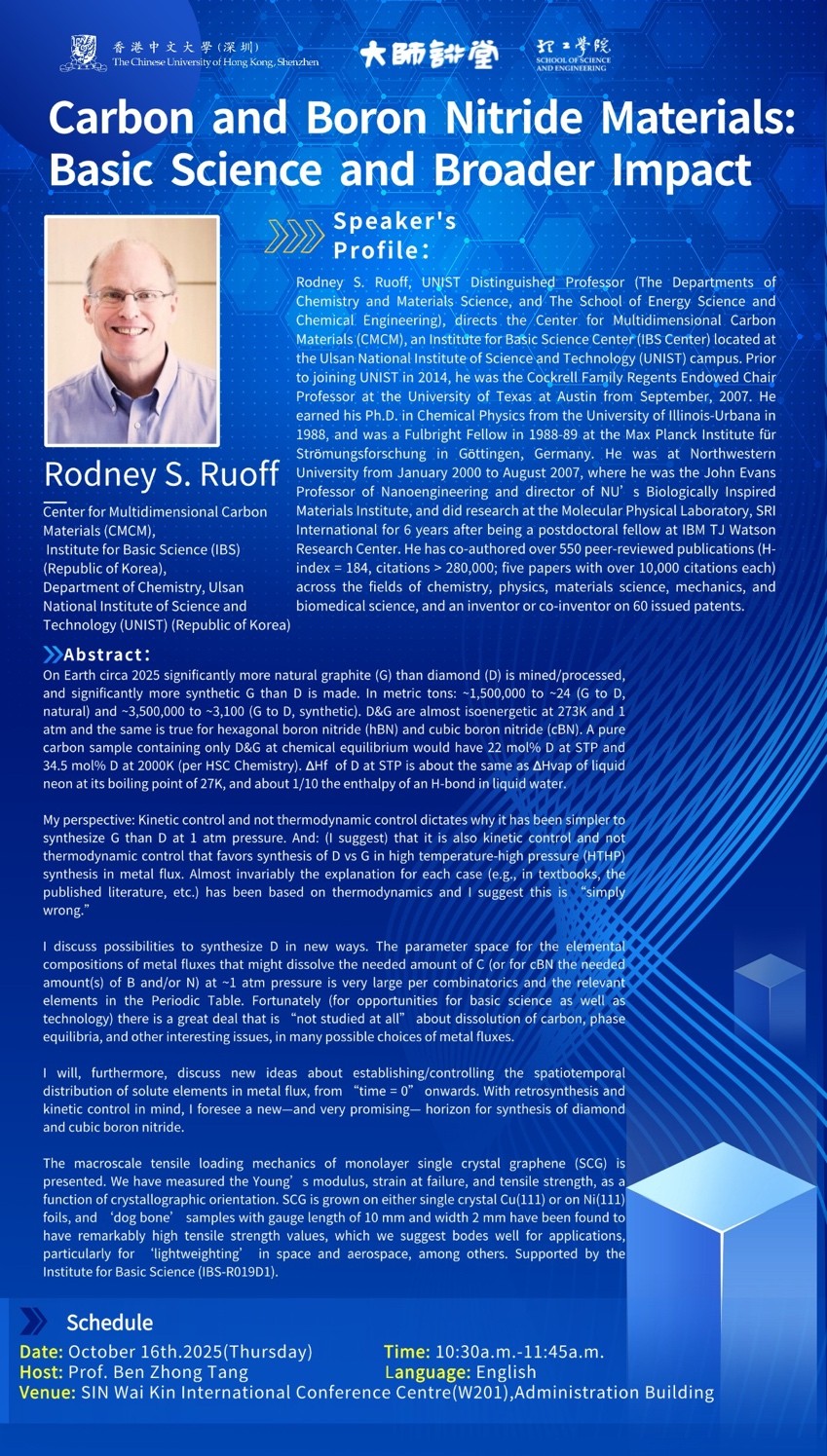【Master Forum】Carbon and Boron Nitride Materials: Basic Science and Broader Impact
Topic: Carbon and Boron Nitride Materials: Basic Science and Broader Impact
Speaker: Prof. Rodney S. Ruof
Host: Prof. Ben Zhong Tang
Date: Thursday, Oct.16, 2025
Time: 10:30 a.m. - 11:45 a.m.
Venue: SIN Wai Kin International Conference Centre (W201), Administration Building
Language: English
?
Abstract:?
On Earth circa 2025 significantly more natural graphite (G) than diamond (D) is mined/processed, and significantly more synthetic G than D is made. In metric tons: ~1,500,000 to ~24 (G to D, natural) and ~3,500,000 to ~3,100 (G to D, synthetic). D&G are almost isoenergetic at 273K and 1 atm and the same is true for hexagonal boron nitride (hBN) and cubic boron nitride (cBN). A pure carbon sample containing only D&G at chemical equilibrium would have 22 mol% D at STP and 34.5 mol% D at 2000K (per HSC Chemistry). ΔHf of D at STP is about the same as ΔHvap of liquid neon at its boiling point of 27K, and about 1/10 the enthalpy of an H-bond in liquid water. My perspective: Kinetic control and not thermodynamic control dictates why it has been simpler to synthesize G than D at 1 atm pressure. And: (I suggest) that it is also kinetic control and not thermodynamic control that favors synthesis of D vs G in high temperature-high pressure (HTHP) synthesis in metal flux. Almost invariably the explanation for each case (e.g., in textbooks, the published literature, etc.) has been based on thermodynamics and I suggest this is “simply wrong”. I will discuss possibilities to synthesize D in new ways. The parameter space for the elemental compositions of metal fluxes that might dissolve the needed amount of C (or for cBN the needed amount(s) of B and/or N) at ~1 atm pressure is very large per combinatorics and the relevant elements in the Periodic Table. Fortunately (for opportunities for basic science as well as technology) there is a great deal that is “not studied at all” about dissolution of carbon, phase equilibria, and other interesting issues, in many possible choices of metal fluxes. I will, furthermore, discuss new ideas about establishing/controlling the spatiotemporal distribution of solute elements in metal flux, from “time = 0” onwards. With retrosynthesis and kinetic control in mind, I foresee a new—and very promising— horizon for synthesis of diamond and cubic boron nitride. The macroscale tensile loading mechanics of monolayer single crystal graphene (SCG) is presented. We have measured the Young’s modulus, strain at failure, and tensile strength, as a function of crystallographic orientation. SCG is grown on either single crystal Cu (111) or on Ni (111) foils, and ‘dog bone’ samples with gauge length of 10 mm and width 2 mm have been found to have remarkably high tensile strength values, which we suggest bodes well for applications, particularly for ‘lightweighting’ in space and aerospace, among others. Supported by the Institute for Basic Science (IBS-R019D1).
?
Speaker’s Profile:
Rodney S. Ruoff, UNIST Distinguished Professor (The Departments of Chemistry and Materials Science, and The School of Energy Science and Chemical Engineering), directs the Center for Multidimensional Carbon Materials (CMCM), an Institute for Basic Science Center (IBS Center) located at the Ulsan National Institute of Science and Technology (UNIST) campus. Prior to joining UNIST in 2014, he was the Cockrell Family Regents Endowed Chair Professor at the University of Texas at Austin from September, 2007. He earned his Ph.D. in Chemical Physics from the University of Illinois-Urbana in 1988, and was a Fulbright Fellow in 1988-89 at the Max Planck Institute für Str?mungsforschung in G?ttingen, Germany. He was at Northwestern University from January 2000 to August 2007, where he was the John Evans Professor of Nanoengineering and director of NU’s Biologically Inspired Materials Institute, and did research at the Molecular Physical Laboratory, SRI International for 6 years after being a postdoctoral fellow at IBM TJ Watson Research Center. He has co-authored over 550 peer-reviewed publications (H-index = 184, citations > 280,000; five papers with over 10,000 citations each) across the fields of chemistry, physics, materials science, mechanics, and biomedical science, and an inventor or co-inventor on 60 issued patents.
?






